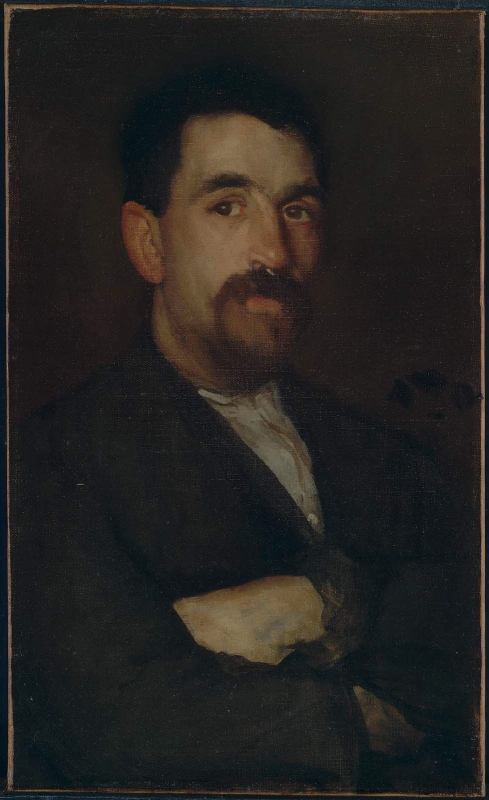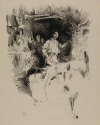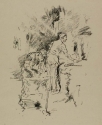Home > Catalogue > Browse > The Master Smith of Lyme Regis << >>
Titles
Minor variations on the title have been suggested:
- 'The Master Smith' (1896, D. C. Thomson). 1
- 'Master Smith' (1895, Whistler). 2
- 'The Blacksmith' (1901, Pan-American Exposition, Buffalo). 3
- 'The Master Smith of Lyme Regis' (1904, Copley Society, Boston). 4
- 'The Master Smith of Lyme Regis' (1980, YMSM). 5
'The Master Smith of Lyme Regis' is the preferred title.
Description
A half-length portrait, in vertical format, of a man in three-quarter view to right. He has dark brown hair, a moustache and small beard. His arms are folded. He wears a black jacket over a white shirt with no collar. The background is dark brown.
Sitter
Samuel Edward Govier (1857-1934), a blacksmith, died in December 1934. Whistler also painted his daughter (Devonshire Daisy [YMSM 446]), and his smithy was the subject of The Little Forge, Lyme Regis [YMSM 442]. His father George Govier (1825-1903) was master smith before him.
Whistler made several lithographs featuring the smiths and smithy including The Master Smith c120, Father and Son c123, The Blacksmith c127, and The Brothers c128.
Robert Thurston Hopkins described and photographed Govier at work in his smithy off Broad Street, Lyme Regis, in a delightful travelogue, Thomas Hardy's Dorset, published in 1922:
'Broad Street, leading downwards from the station to the sea, is the main thoroughfare, and the principal business part of the town. Half-way up the street on the eastern side is a small passage leading to an ancient forge. It is scarcely to be noticed unless one is expressly seeking for it, but once up the narrow court there it is, with its open doorway all red inside like a wizard's cave, with the hammers ringing on the anvil, and the sparks showering out of the big flue. Here Vulcan has toiled ... for five hundred years without a break, and here, in spite of cheap machinery, Mr Govier, the master smith of Lyme Regis, still seems to enjoy a regular and ready custom. The forge has been in Mr Govier's family for three hundred years, and it has a great weather-beaten wooden-and-tile roof, which is all but on the verge of collapse. A long sweep of old oak wood controls the bellows, and as you look in you will see the hand of Govier himself is on the bellows handle. He draws it down and lets it up again with the peculiar rhythmic motion of long experience, heaping up his fire with a cunning little iron rake, singing a most doleful song to himself all about "shooting his true love at the setting of the sun." But you must not think the master smith is a gloomy man, for this song... is just a tune of acquiescence to his labours—a song in sympathy with the roar of the bellows and the ascending sparks of his fire.
"Come in, come in," he said, when I told him I had come to pay my respects to him.
He turned from his forge, set his hands on his hips and looked at me a moment. Then I realised why McNeill Whistler spent so much of his time in this forge making sketches of the smith. He looked like Vulcan's very brother, his face sunburnt and forge-burnt to wheat-colour, his eyes blue as cornflowers, and his hair black and crisp, and everywhere about him the atmosphere of the blacksmith. There are all kinds of interesting things in the old forge, from Roman horseshoes to plates for race-horses, and a pair of old beam-scales dated 1560. These scales have been hanging up as far back as Govier and his father before him could remember. Besides having the knowledge of a craftsman, Govier is a singer of old songs.
"That song you were singing when I came in?" I asked. "I know it as well as anyone, but somehow it has escaped me."
"Ah!" said the master smith. "Well, well! It is years ago now that I first heard it, when the ships came inside our walls with coal and took away stone. We rarely see a ship in our walls now, but when I was a boy my father and I frequently went down to the quay to repair ironwork aboard the old sailing boats. Those old Devon sailors were the fellows for songs. ... The man who sings loudly and clearly is in good health, prompt, and swift to the point, and his heart is as big as parson's barn.' 6
Notes:
1: D. C. Thomson to Whistler, 2 November 1895, GUW #05827.
2: Whistler to D. C. Thomson, [6 November 1895], GUW #08393.
3: Pan-American Exposition, Buffalo, 1901 (cat. no. 99).
4: Oil Paintings, Water Colors, Pastels and Drawings: Memorial Exhibition of the Works of Mr. J. McNeill Whistler, Copley Society, Boston, 1904 (cat. no. 36).
5: YMSM 1980 [more] (cat. no. 450).
6: Hopkins, Robert Thurston, Thomas Hardy's Dorset, New York, 1922, pp. 218-21, photograph of smithy repr.; Project Gutenberg website at https://www.gutenberg.org. (acc. 2020).
Last updated: 4th June 2021 by Margaret









